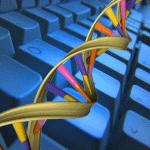Bioinformatics
|
12 october 2017 11:22:04 |
| Molecular dynamics simulation, binding free energy calculation and unbinding pathway analysis on selectivity difference between FKBP51 and FKBP52: Insight into the molecular mechanism of isoform selectivity (Proteins: Structure, Function, and Bioinformatics) |
|
Tweet As co-chaperones of the 90-kDa heat shock protein(HSP90), FK506 binding protein 51 (FKBP51) and FK506 binding protein 52 (FKBP52) modulate the maturation of steroid hormone receptor through their specific FK1 domains (FKBP12-like domain 1). The inhibitors targeting FK1 domains are potential therapies for endocrine-related physiological disorders. However, the structural conservation of the FK1 domains between FKBP51 and FKBP52 make it difficult to obtain satisfactory selectivity in FK506-based drug design. Fortunately, a series of iFit ligands synthesized by Hausch et al exhibited excellent selectivity for FKBP51, providing new opportunity for design selective inhibitors. We performed molecular dynamics simulation, binding free energy calculation and unbinding pathway analysis to reveal selective mechanism for the inhibitor iFit4 binding with FKBP51 and FKBP52. The conformational stability evaluation of the `Phe67-in` and `Phe67-out` states implies that FKBP51 and FKBP52 have different preferences for `Phe67-in` and `Phe67-out` states, which we suggest as the determinant factor for the selectivity for FKBP51. The binding free energy calculations demonstrate that nonpolar interaction is favorable for the inhibitors binding, while the polar interaction and entropy contribution are adverse for the inhibitors binding. According to the results from binding free energy decomposition, the electrostatic difference of residue 85 causes the most significant thermodynamics effects on the binding of iFit4 to FKBP51 and FKBP52. Furthermore, the importance of substructure units on iFit4 were further evaluated by unbinding pathway analysis and residue-residue contact analysis between iFit4 and the proteins. The results will provide new clues for the design of selective inhibitors for FKBP51. This article is protected by copyright. All rights reserved. |
| 123 viewsCategory: Biochemistry, Bioinformatics |
 Computational characterization of substrate and product specificities, and functionality of SAM binding pocket in histone lysine methyltransferases from Arabidopsis, rice and maize (Proteins: Structure, Function, and Bioinformatics) Computational characterization of substrate and product specificities, and functionality of SAM binding pocket in histone lysine methyltransferases from Arabidopsis, rice and maize (Proteins: Structure, Function, and Bioinformatics)Definition and classification of evaluation units for tertiary structure prediction in CASP12 facilitated through semi-automated metrics (Proteins: Structure, Function, and Bioinformatics) 
|
| blog comments powered by Disqus |
MyJournals.org
The latest issues of all your favorite science journals on one page
The latest issues of all your favorite science journals on one page



